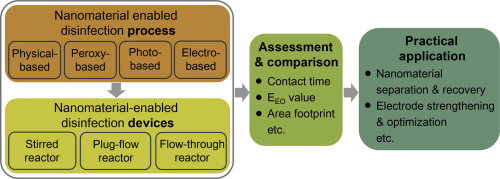当前位置:
X-MOL 学术
›
Water Res.
›
论文详情
Our official English website, www.x-mol.net, welcomes your feedback! (Note: you will need to create a separate account there.)
Evaluation and prospects of nanomaterial-enabled innovative processes and devices for water disinfection: A state-of-the-art review.
Water Research ( IF 12.8 ) Pub Date : 2020-02-05 , DOI: 10.1016/j.watres.2020.115581 Zheng-Yang Huo 1 , Ye Du 2 , Zhuo Chen 3 , Yin-Hu Wu 3 , Hong-Ying Hu 4
Water Research ( IF 12.8 ) Pub Date : 2020-02-05 , DOI: 10.1016/j.watres.2020.115581 Zheng-Yang Huo 1 , Ye Du 2 , Zhuo Chen 3 , Yin-Hu Wu 3 , Hong-Ying Hu 4
Affiliation

|
This study provided an overview of established and emerging nanomaterial (NM)-enabled processes and devices for water disinfection for both centralized and decentralized systems. In addition to a discussion of major disinfection mechanisms, data on disinfection performance (shortest contact time for complete disinfection) and energy efficiency (electrical energy per order; EEO) were collected enabling assessments firstly for disinfection processes and then for disinfection devices. The NM-enabled electro-based disinfection process gained the highest disinfection efficiency with the lowest energy consumption compared with physical-based, peroxy-based, and photo-based disinfection processes owing to the unique disinfection mechanism and the direct mean of translating energy input to microbes. Among the established disinfection devices (e.g., the stirred, the plug-flow, and the flow-through reactor), the flow-through reactor with mesh/membrane or 3-dimensional porous electrodes showed the highest disinfection performance and energy efficiency attributed to its highest mass transfer efficiency. Additionally, we also summarized recent knowledge about current and potential NMs separation and recovery methods as well as electrode strengthening and optimization strategies. Magnetic separation and robust immobilization (anchoring and coating) are feasible strategies to prompt the practical application of NM-enabled disinfection devices. Magnetic separation effectively solved the problem for the separation of evenly distributed particle-sized NMs from microbial solution and robust immobilization increased the stability of NM-modified electrodes and prevented these electrodes from degradation by hydraulic detachment and/or electrochemical dissolution. Furthermore, the study of computational fluid dynamics (CFD) was capable of simulating NM-enabled devices, which showed great potential for system optimization and reactor expansion. In this overview, we stressed the need to concern not only the treatment performance and energy efficiency of NM-enabled disinfection processes and devices but also the overall feasibility of system construction and operation for practical application.
中文翻译:

纳米材料实现的水消毒创新工艺和设备的评估和前景:最新技术审查。
这项研究概述了已建立和正在兴起的纳米材料(NM)启用的过程和设备的集中式和分散式系统的水消毒。除了讨论主要消毒机制外,还收集了有关消毒性能(完成消毒的最短接触时间)和能效(每订单电能; EEO)的数据,从而可以首先对消毒过程进行评估,然后对消毒设备进行评估。与基于物理,基于过氧和基于光的消毒过程相比,由于具有独特的消毒机制和直接将能量输入转化为能量的方式,与基于物理,基于过氧和基于光的消毒过程相比,启用NM的电基消毒过程获得了最高的消毒效率和最低的能耗。微生物。在已建立的消毒设备中(例如,搅拌,活塞流和流通式反应器),带网孔/膜或3维多孔电极的流通式反应器显示出最高的消毒性能和能效,这归因于其最高的传质效率。此外,我们还总结了有关当前和潜在的NMs分离和回收方法以及电极强化和优化策略的最新知识。磁分离和坚固的固定(锚固和涂层)是可行的策略,可促进NM消毒设备的实际应用。磁分离有效地解决了从微生物溶液中分离出均匀分布的颗粒状NM的问题,并且牢固的固定提高了NM修饰电极的稳定性,并防止了这些电极因水力分离和/或电化学溶解而降解。此外,对计算流体动力学(CFD)的研究能够模拟启用NM的设备,这显示了系统优化和反应堆扩展的巨大潜力。在本概述中,我们强调不仅需要关注启用NM的消毒过程和设备的处理性能和能效,还需要关注系统构建和实际应用的总体可行性。对计算流体动力学(CFD)的研究能够模拟启用NM的设备,这显示了系统优化和反应堆扩展的巨大潜力。在本概述中,我们强调不仅需要关注启用NM的消毒过程和设备的处理性能和能效,还需要关注系统构建和实际应用的总体可行性。对计算流体动力学(CFD)的研究能够模拟启用NM的设备,这显示了系统优化和反应堆扩展的巨大潜力。在本概述中,我们强调不仅需要关注启用NM的消毒过程和设备的处理性能和能效,还需要关注系统构建和实际应用的总体可行性。
更新日期:2020-02-06
中文翻译:

纳米材料实现的水消毒创新工艺和设备的评估和前景:最新技术审查。
这项研究概述了已建立和正在兴起的纳米材料(NM)启用的过程和设备的集中式和分散式系统的水消毒。除了讨论主要消毒机制外,还收集了有关消毒性能(完成消毒的最短接触时间)和能效(每订单电能; EEO)的数据,从而可以首先对消毒过程进行评估,然后对消毒设备进行评估。与基于物理,基于过氧和基于光的消毒过程相比,由于具有独特的消毒机制和直接将能量输入转化为能量的方式,与基于物理,基于过氧和基于光的消毒过程相比,启用NM的电基消毒过程获得了最高的消毒效率和最低的能耗。微生物。在已建立的消毒设备中(例如,搅拌,活塞流和流通式反应器),带网孔/膜或3维多孔电极的流通式反应器显示出最高的消毒性能和能效,这归因于其最高的传质效率。此外,我们还总结了有关当前和潜在的NMs分离和回收方法以及电极强化和优化策略的最新知识。磁分离和坚固的固定(锚固和涂层)是可行的策略,可促进NM消毒设备的实际应用。磁分离有效地解决了从微生物溶液中分离出均匀分布的颗粒状NM的问题,并且牢固的固定提高了NM修饰电极的稳定性,并防止了这些电极因水力分离和/或电化学溶解而降解。此外,对计算流体动力学(CFD)的研究能够模拟启用NM的设备,这显示了系统优化和反应堆扩展的巨大潜力。在本概述中,我们强调不仅需要关注启用NM的消毒过程和设备的处理性能和能效,还需要关注系统构建和实际应用的总体可行性。对计算流体动力学(CFD)的研究能够模拟启用NM的设备,这显示了系统优化和反应堆扩展的巨大潜力。在本概述中,我们强调不仅需要关注启用NM的消毒过程和设备的处理性能和能效,还需要关注系统构建和实际应用的总体可行性。对计算流体动力学(CFD)的研究能够模拟启用NM的设备,这显示了系统优化和反应堆扩展的巨大潜力。在本概述中,我们强调不仅需要关注启用NM的消毒过程和设备的处理性能和能效,还需要关注系统构建和实际应用的总体可行性。


























 京公网安备 11010802027423号
京公网安备 11010802027423号